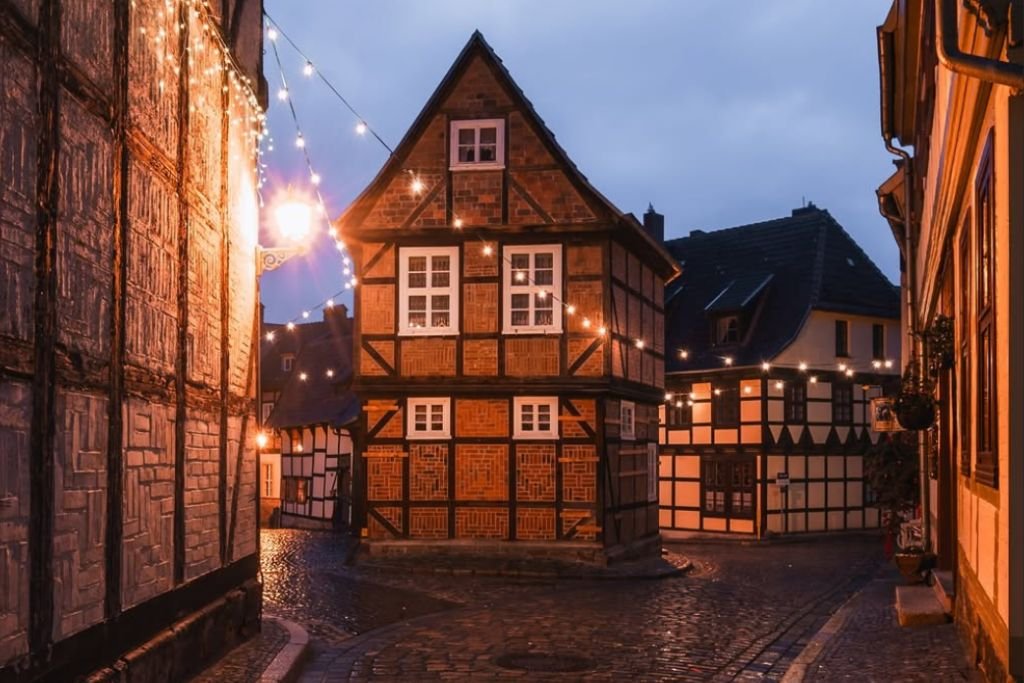Underrated German Towns You Must Visit: Hidden Gems Beyond the Tourist Trail

Germany is a country renowned for its fairy-tale castles, bustling cities like Berlin and Munich, and iconic landmarks such as Neuschwanstein and the Brandenburg Gate. However, beyond these well-trodden paths lie charming, underrated towns that offer an authentic glimpse into Germany’s rich history, culture, and natural beauty.
If you’re looking to escape the crowds and discover hidden gems in Germany, this guide will introduce you to non-touristy places in Germany that deserve a spot on your travel itinerary. From medieval villages to scenic river towns, these underrated German towns promise unforgettable experiences.
1. Quedlinburg – A Medieval Masterpiece
Why Visit? UNESCO-listed half-timbered houses, untouched medieval charm.
Nestled in the Harz Mountains, Quedlinburg is a perfectly preserved medieval town that feels like stepping into a storybook. With over 1,300 half-timbered houses dating back six centuries, this UNESCO World Heritage Site is one of Germany’s best-kept secrets.
Highlights:
- Quedlinburg Abbey – A stunning Romanesque church with panoramic views.
- Old Town (Altstadt) – Wander cobbled streets lined with colorful timber-framed houses.
- Schlossberg Castle – Offers sweeping views of the town and surrounding countryside.
Tip: Visit during Christmas for one of Germany’s most magical markets—without the crowds of Nuremberg or Dresden.
2. Bamberg – The Venice of Franconia
Why Visit? A picturesque riverside town with unique smoked beer.
Bamberg, another UNESCO gem, is famous for its medieval and baroque architecture and its distinctive smoked beer (Rauchbier). Built across seven hills and divided by the Regnitz River, Bamberg’s charm rivals that of Venice.
Highlights:
- Bamberg Cathedral – A masterpiece of Romanesque and Gothic architecture.
- Altes Rathaus (Old Town Hall) – A fairytale-like building perched on an island in the river.
- Little Venice (Klein Venedig) – A row of quaint fishermen’s houses along the water.
Tip: Try Rauchbier at Schlenkerla, a historic brewery serving this unique smoky-flavored beer since 1405.
3. Meissen – The Birthplace of European Porcelain
Why Visit? Stunning hilltop castle and world-famous porcelain.
Often overshadowed by Dresden, Meissen is a hidden treasure in Saxony. Known as the home of European porcelain, this town boasts a majestic castle, vineyards, and a charming old town.
Highlights:
- Albrechtsburg Castle – Germany’s oldest castle, offering breathtaking views.
- Meissen Porcelain Manufactory – Tour the factory where exquisite porcelain has been made since 1710.
- Meissen Cathedral – A Gothic masterpiece with intricate sculptures.
Tip: Sample local Saxon wines from the surrounding vineyards.
4. Monschau – A Fairytale in the Eifel Region
Why Visit? A postcard-perfect town with half-timbered houses and a romantic river setting.
Tucked away in the Eifel region near Belgium, Monschau looks like it was plucked from a Brothers Grimm tale. Its narrow alleys, timber-framed homes, and the Rur River winding through the center create an enchanting atmosphere.
Highlights:
- Monschau Castle – A 13th-century fortress with panoramic views.
- Mustard Mill (Senfmühle Monschau) – Taste traditional German mustard.
- Christmas Market – One of Germany’s coziest, with fewer tourists.
Tip: Visit in winter when the town is dusted in snow, making it even more magical.
5. Görlitz – Germany’s Eastern Hidden Gem
Why Visit? A beautifully preserved town with over 4,000 historic buildings.
Located on the Polish border, Görlitz is one of Germany’s most stunning yet overlooked towns. Its pristine architecture spans Gothic, Renaissance, Baroque, and Art Nouveau styles. Hollywood loves it too—scenes from The Grand Budapest Hotel were filmed here.
Highlights:
- Görlitz Old Town – Wander streets untouched by war or modernization.
- Holy Trinity Church – A breathtaking example of Gothic architecture.
- Neisse River Promenade – Stroll along the river with views into Poland.
Tip: Cross the bridge into Zgorzelec, Poland, for a unique two-country visit.
6. Cochem – A Rhine Valley Fairytale
Why Visit? A dreamy riverside town with a hilltop castle.
While the Rhine Valley is famous for its castles, Cochem remains a quieter alternative to tourist-heavy spots like Rüdesheim. Its Reichsburg Castle towers over the Moselle River, surrounded by vineyards.
Highlights:
- Reichsburg Castle – Take a guided tour of this beautifully restored fortress.
- Moselle River Cruises – Enjoy scenic boat trips through wine country.
- Cochem’s Market Square – Lined with pastel-colored houses and cozy cafés.
Tip: Visit in late summer for wine festivals celebrating Riesling grapes.
7. Lüneburg – A Hanseatic Beauty
Why Visit? A medieval trading town with a unique tilt.
Lüneburg, near Hamburg, was once a wealthy salt-trading hub. Its leaning houses (due to salt mining) and red-brick Gothic architecture give it a distinctive charm.
Highlights:
- St. John’s Church – A stunning example of North German brick Gothic style.
- Lüneburg Salt Museum – Learn about the town’s “white gold” history.
- Ilmenau River – Perfect for scenic walks and boat rides.
Tip: Don’t miss the Lüneburg Heath in late summer when the purple heather blooms.
8. Tübingen – A University Town with Timeless Charm
Why Visit? A lively yet laid-back medieval town with a youthful vibe.
Home to one of Germany’s oldest universities, Tübingen blends historic charm with a vibrant student culture. Its half-timbered houses and riverside setting make it irresistibly picturesque.
Highlights:
- Hohentübingen Castle – Offers great views and a fascinating museum.
- Neckar River Punts – Try traditional wooden boat rides.
- Market Square (Marktplatz) – The heart of the town’s café culture.
Tip: Visit in June for the Stocherkahnrennen, a quirky boat race.
9. Rothenburg ob der Tauber (Beyond the Main Town)
Why Visit? A quieter alternative to the famous Rothenburg.
While Rothenburg ob der Tauber is a well-known tourist spot, nearby towns like Dinkelsbühl and Nördlingen offer similar medieval charm without the crowds.
Highlights:
- Dinkelsbühl – A perfectly preserved walled town with colorful houses.
- Nördlingen – Built inside a meteor crater, with a unique medieval feel.
Tip: Walk the Romantic Road to discover these lesser-known gems.
10. Wernigerode – Gateway to the Harz Mountains
Why Visit? A colorful town with a fairy-tale castle and steam trains.
Wernigerode is often overlooked for Quedlinburg, but its vibrant town hall and hilltop castle make it equally captivating. It’s also the starting point for the Harz Narrow Gauge Railway, a scenic steam train ride.
Highlights:
- Wernigerode Castle – A stunning mix of Gothic and Renaissance styles.
- Harz Railway – Ride a historic steam train to the Brocken summit.
- Town Hall (Rathaus) – One of Germany’s most photogenic buildings.
Tip: Visit in autumn for stunning fall foliage in the Harz Mountains.
Why Visit These Underrated German Towns?
Germany’s hidden gems offer:
✅ Fewer crowds – Escape mass tourism.
✅ Authentic experiences – Discover local traditions and untouched beauty.
✅ Stunning architecture – Medieval, Renaissance, and Baroque wonders.
✅ Natural beauty – From river valleys to mountain landscapes.
If you’re planning a trip to Germany, skip the usual hotspots and explore these underrated German towns instead. You’ll uncover a side of Germany that most tourists never see.
Ready to Explore?
Which of these hidden gems in Germany will you visit first? Let us know in the comments!
#Germany #HiddenGems #TravelOffTheBeatenPath #UnderratedTowns #NonTouristyGermany
Would you like recommendations for specific regions or activities? Let us know—we’re happy to help!






